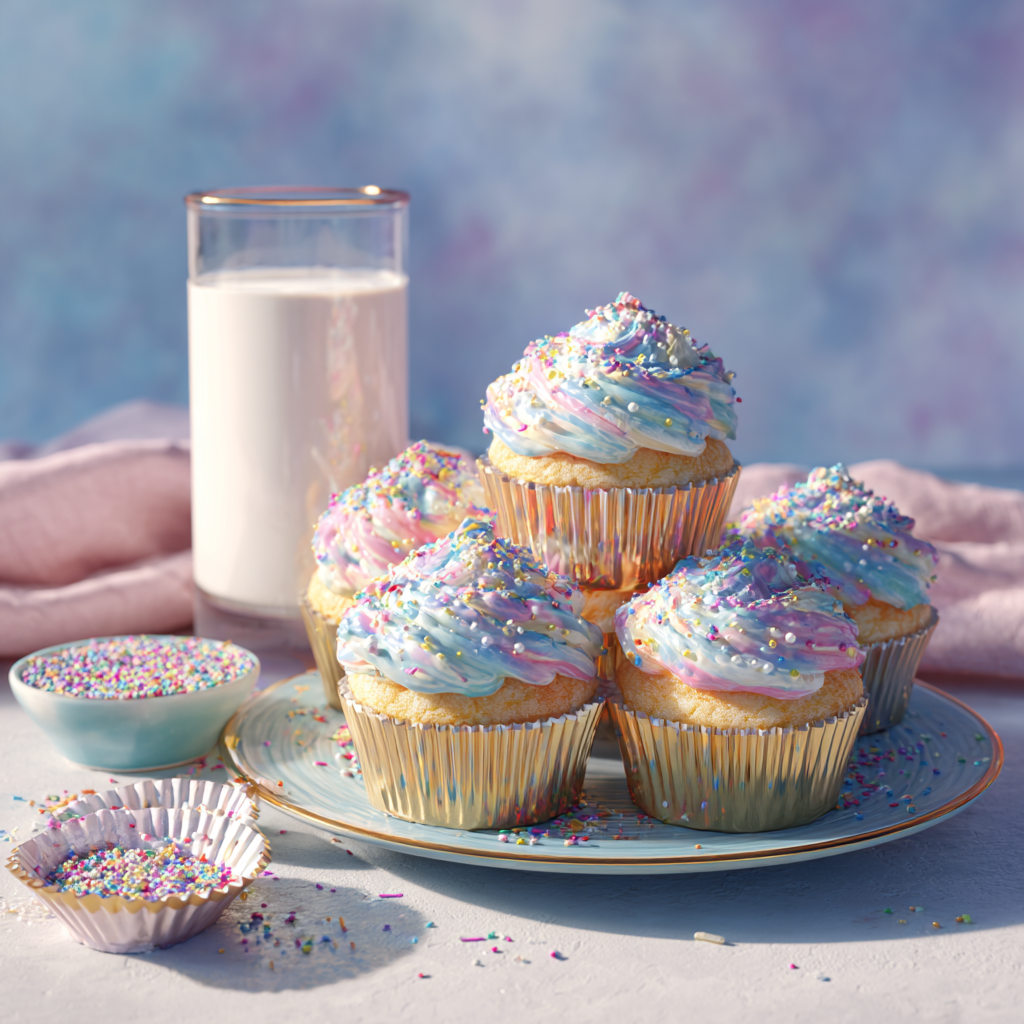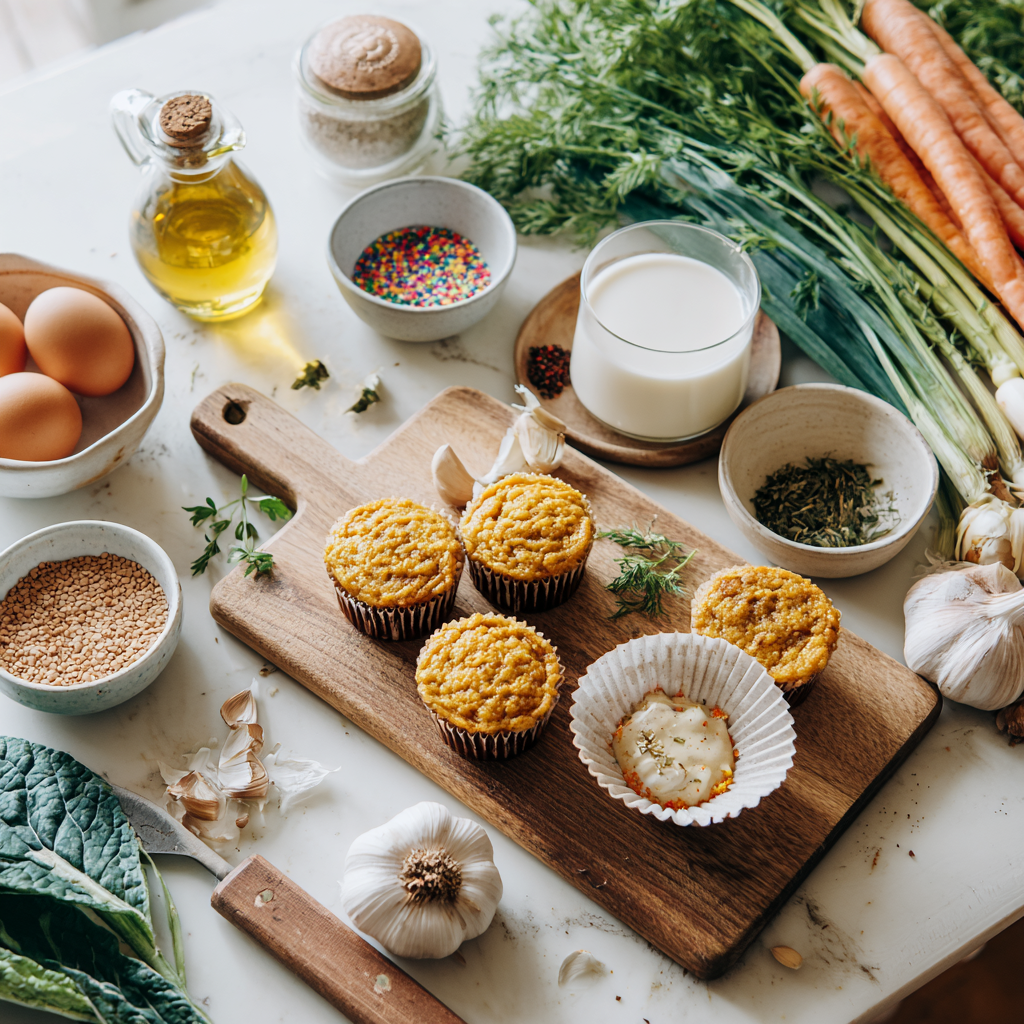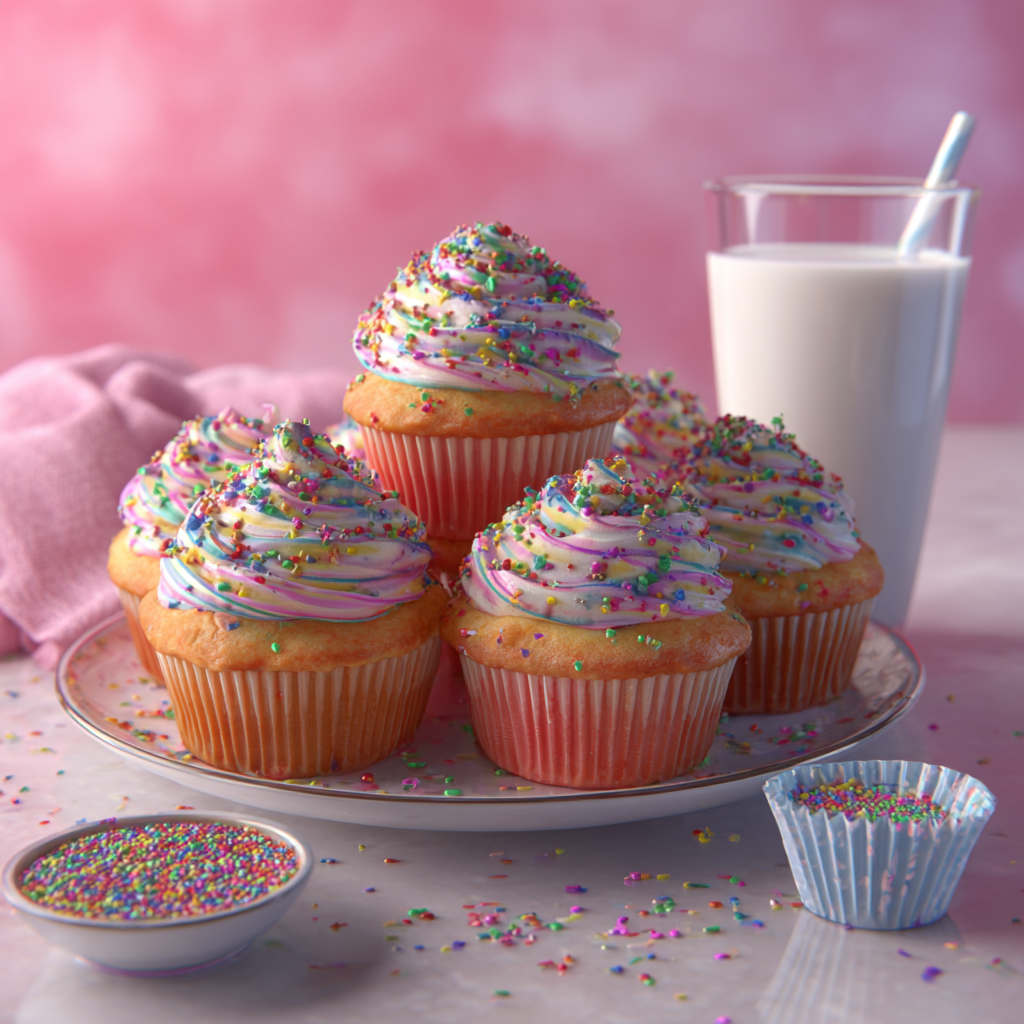
Introduction
Baking has always been my happy place. There’s something magical about turning simple ingredients into sweet treats that bring people together. But as much as I love traditional recipes, I’ve learned that not everyone can enjoy them the same way. A few years ago, a close friend shared how tough it was for her to find desserts she could eat because of lactose intolerance. That’s when I decided to create a lactose free cupcake recipe that didn’t skimp on flavor or texture.
This recipe is perfect for anyone avoiding dairy but still craving something indulgent. Whether you’re lactose intolerant, vegan, or just experimenting with new ingredients, these cupcakes will satisfy your sweet tooth. Plus, they’re so moist and fluffy, no one will guess they’re dairy-free. Let’s dive into why going lactose-free doesn’t mean giving up delicious baked goods.
Why Go Lactose Free?
I’ve seen firsthand how frustrating lactose intolerance can be. My friend would often skip dessert at gatherings because she didn’t want to risk feeling unwell later. It broke my heart knowing she had to miss out. Turns out, she’s not alone. Millions of people in the USA deal with lactose intolerance, and the demand for lactose-free options keeps growing.
The good news? Adapting recipes like this lactose free cupcake recipe is easier than you might think. You don’t need fancy tools or hard-to-find ingredients. Simple swaps can make all the difference without sacrificing taste. For example, many people wonder, Can I use lactose free milk in baking recipes? The answer is yes—and it works beautifully.
Lactose free milk behaves almost exactly like regular milk in baking. It blends smoothly, adds moisture, and helps create that soft crumb we all love. In fact, most people won’t even notice the difference. Later in this article, I’ll share more tips on choosing the best lactose free milk to bake with, so stay tuned.
Choosing the Right Ingredients
When making a lactose free cupcake recipe, picking the right ingredients is key. Not all substitutes are created equal, and some work better than others. Let’s start with milk—one of the most important components. Not every lactose free milk performs the same way in baking. Here’s what to look for:
- Consistency: Choose a milk that’s creamy and thick, like whole milk. Almond or oat milk can work too, but thinner options may require tweaking the recipe.
- Flavor: Opt for unsweetened varieties to avoid altering the sweetness of your cupcakes.
- Neutral Taste: Some plant-based milks have strong flavors that can overpower delicate batters. Stick to mild options like cashew or coconut milk (not the canned kind).
Another big question is what to use instead of butter. Butter gives cupcakes their rich flavor and tender texture, but there are plenty of alternatives. Coconut oil is a great choice—it adds moisture and pairs well with sweet flavors. Vegan margarine also works wonders if you want something closer to traditional butter.
Here’s a quick comparison of butter substitutes:
| Substitute | Best For | Tips |
|---|---|---|
| Coconut Oil | Moisture and richness | Use refined coconut oil for a neutral taste. |
| Vegan Margarine | Buttery flavor | Make sure it’s labeled “dairy-free.” |
| Olive Oil | Healthier option | Best for recipes where a slight fruity note complements the flavor. |
Remember, the goal is to keep things simple while ensuring your cupcakes turn out light and flavorful. With the right ingredients, you won’t believe how easy it is to whip up a batch of these lactose free cupcakes. Now let’s talk about how to adjust other parts of the recipe for success.

Step-by-Step Guide to Making Lactose Free Cupcakes
Alright, so we’ve covered the “why” and the “what” of making lactose free cupcakes. Now it’s time for the fun part—actually baking them! Trust me, this process is just as enjoyable as eating the final product. You don’t need any fancy gadgets or crazy skills. If you can measure and mix, you’re golden.
Gathering Your Supplies
Let’s start with the basics. The tools you’ll need for this lactose free cupcake recipe are probably already in your kitchen. A mixing bowl, whisk, measuring cups, and a muffin tin are all you really need. Oh, and don’t forget the cupcake liners—they save you from scrubbing stuck-on batter later. By the way, I always use parchment liners because they peel off cleanly. Nobody likes half their cupcake stuck to the paper, right?
One thing I love about this recipe is how approachable it is. Honestly, if you’ve ever baked anything before, you’re good to go. No special equipment required. In fact, I once made these using just a fork and a bowl when my mixer decided to take an unexpected vacation. Crisis averted!
Preparing the Batter
Now, let’s talk about the magic that happens in the bowl. Start by whisking together your dry ingredients—flour, sugar, baking powder, and a pinch of salt. This step might seem boring, but trust me, it’s crucial. Mixing them first ensures everything is evenly distributed, so no one bites into a pocket of flour. Not fun, trust me—I’ve been there.
Once your dry mix is ready, it’s time to bring in the wet team. Here’s where you’ll swap out regular milk for lactose free milk. How to make a cake lactose free? This is where the magic begins. Just pour in your chosen milk (I prefer oat milk for its creamy texture), along with some oil or melted vegan butter. Crack in an egg—or a flax egg if you’re going fully vegan—and give it a good stir. The batter should come together smoothly, with no lumps. If it’s too thick, add a splash more milk. Too thin? A tablespoon of flour will fix it.
Funny enough, the first time I tried this recipe, I accidentally used double the oil. Let’s just say those cupcakes were… interesting. But hey, even mistakes can teach you something. Overmixing is another rookie mistake to avoid—it makes the gluten in the flour toughen up, leaving you with dense cupcakes. Stir until *just* combined, and you’re good to go.
Baking Tips for Perfect Cupcakes
Okay, here’s the moment of truth: popping those babies into the oven. Preheat your oven to 350°F (175°C). This temperature works like a charm for most cupcake recipes, including my dairy free cupcake recipe. Fill each liner about two-thirds full—any more, and they’ll spill over; any less, and they won’t rise properly.
Timing is everything. Depending on your oven, these should bake for about 18–22 minutes. To check if they’re done, stick a toothpick in the center. If it comes out clean, you’re golden. If not, give them another minute or two. Quick tip: Don’t open the oven door too often while they’re baking. Every time you do, you lose heat, and your cupcakes might sink. Ask me how I know.
Here’s the thing about lactose free cupcakes: they bake almost exactly like their dairy-filled counterparts. So yes, to answer the question Can I use lactose free milk in cupcakes?, absolutely! I’ve tested this countless times, and the results are always spot-on. They rise beautifully, have a soft crumb, and taste amazing. Honestly, most people wouldn’t even notice the difference unless you told them.
Frosting Options Without Dairy
Now, let’s talk frosting. Because what’s a cupcake without frosting? Sure, you could leave them plain, but why would you when there are so many delicious options? For a truly indulgent treat, try whipped coconut cream. It’s light, fluffy, and pairs perfectly with these cupcakes. Just chill a can of full-fat coconut milk overnight, scoop out the solid part, and whip it with a bit of powdered sugar and vanilla extract. Easy peasy.
If you’re feeling adventurous, check out my charlotte russe cupcake recipe for inspiration. While it’s not lactose free, you can adapt the frosting by using almond-based buttercream instead of traditional buttercream. Seriously, almond butter mixed with powdered sugar and a splash of vanilla creates a rich, creamy topping that everyone will love.
Want to get creative? Add some flair! Drizzle melted chocolate over the top, sprinkle crushed nuts, or swirl in a bit of fruit puree. I recently topped mine with a raspberry drizzle, and wow—it was next-level good. Pro tip: Pair fruity flavors with citrusy cupcakes for a refreshing twist. My coquito cupcake recipe includes a coconut-lime variation that works wonders here.
By the way, if you’re looking for something simpler, a dusting of powdered sugar does the trick. Sometimes less really is more. Plus, it gives your cupcakes a classy, minimalist vibe. Just saying.
Troubleshooting Common Issues
Even the best bakers run into hiccups sometimes. Maybe your cupcakes didn’t rise as much as you’d hoped, or the frosting turned out grainy. Don’t panic—it happens to the best of us. Here’s what to do:
- Dense Cupcakes: Chances are, you either overmixed the batter or skipped the baking powder. Remember, gentle hands are key!
- Grainy Frosting: This usually means your powdered sugar wasn’t sifted. Take the extra minute to sift it—it makes a world of difference.
- Flat Tops: Oven temperature could be the culprit. Invest in an oven thermometer to ensure accuracy. Or, try my milk free cupcake recipe, which uses a bit of vinegar for extra lift.
Here’s the deal: Baking is part science, part art. Some days, things go perfectly. Other days, you end up with cupcakes that look more like pancakes. And that’s okay. Every batch teaches you something new. Plus, imperfect cupcakes still taste amazing, am I right?
Final Thoughts Before You Bake
So there you have it—a complete guide to making lactose free cupcakes that rival any bakery creation. Whether you’re whipping these up for yourself, a friend, or a crowd, they’re sure to impress. Keep experimenting with flavors and toppings—you never know what masterpiece you’ll create next.
Oh, and one last thing: Share your creations! Tag me in your photos if you try this recipe—I’d love to see how they turn out. Happy baking! 🧁

Serving and Storing Your Lactose Free Cupcakes
Okay, so you’ve baked your lactose free cupcakes, and they’re looking gorgeous. Now what? Whether you’re serving them at a party or saving them for later, presentation and storage matter. Let’s dive into how to make these treats shine on any occasion.
If you’re bringing these cupcakes to a gathering, think about how they’ll stand out. A tiered cupcake stand is always a showstopper—it adds height and drama, making your desserts the center of attention. Funny enough, I once forgot my stand and used an upside-down mixing bowl covered with a cloth. Not Pinterest-worthy, but it worked in a pinch! Garnish them creatively: fresh berries, edible flowers, or even a sprinkle of cinnamon can elevate their look. If you’re feeling extra fancy, pair each cupcake with a small note describing the flavor. It’s a thoughtful touch that guests always appreciate.
By the way, if you’re hosting kids (or adults who act like kids), colorful sprinkles are your best friend. They scream fun without any extra effort. Just don’t overdo it, unless you’re going for that “carnival” vibe. Trust me, I learned that lesson after one too many sprinkle explosions.
Now, let’s talk storage. Nobody wants stale cupcakes, right? To keep them fresh, store them in an airtight container at room temperature for up to two days. If you need them to last longer, pop them in the fridge—but here’s the thing: cold cupcakes can dry out faster. To combat this, place a slice of bread in the container with them. Sounds weird, I know, but the cupcakes will absorb moisture from the bread, staying soft and delicious. Pro tip: Take them out of the fridge about 30 minutes before serving to bring them back to room temp.
Freezing is another option if you’ve made a big batch. Wrap each cupcake individually in plastic wrap, then place them in a freezer-safe bag. When you’re ready to enjoy one, thaw it at room temperature or give it a quick zap in the microwave. Honestly, frozen cupcakes have saved me more than once when unexpected guests dropped by. Who knew dessert emergencies could be so easy to handle?
Here’s the beauty of these lactose free cupcakes: they’re versatile. Whether it’s a birthday, holiday, or just a random Tuesday, they fit the bill. I’ve served them at everything from baby showers to book club meetings, and they’ve always been a hit. People love that they’re inclusive—no one feels left out because of dietary restrictions.
Common Mistakes to Avoid
Baking is forgiving, but there are still some pitfalls to watch out for, especially when adapting recipes to be lactose free. Here’s where things can go sideways—and how to fix them.
First up, overthinking substitutions. Some folks stress about finding the “perfect” alternative for every ingredient. Relax! This lactose free cupcake recipe works beautifully with simple swaps. Stick to tried-and-true options like oat milk or coconut oil, and you’ll be fine. Overcomplicating things just leads to frustration—and possibly a kitchen disaster. Speaking of disasters, I once tried using water instead of milk because I was out of everything else. Spoiler alert: it didn’t work.
Another common worry is that lactose-free baked goods won’t taste as good. But guess what? These cupcakes prove that theory wrong. The key is balancing flavors. For example, if you use coconut milk, its subtle sweetness complements the batter perfectly. And let’s not forget the frosting—whipped coconut cream or almond-based buttercream adds richness without overpowering the cupcake itself.
Oh, and here’s something I see all the time: people skipping the sifting step. Sure, it seems tedious, but sifting powdered sugar for frosting makes a huge difference. Grainy frosting? No thanks. Take the extra minute—it’s worth it. Trust me, I’ve been there, scraping gritty frosting off cupcakes while muttering under my breath.
Finally, resist the urge to peek inside the oven too often. Every time you open the door, heat escapes, which can cause uneven baking. I learned this the hard way when my cupcakes came out looking like sad little pancakes. Lesson learned: patience pays off.
Frequently Asked Questions (FAQ)
Can I use lactose free milk in baking recipes?
Absolutely! Lactose free milk behaves almost identically to regular milk in baking. It blends smoothly, adds moisture, and helps achieve that fluffy texture we all crave. From cakes to cookies, it’s a seamless swap. Just stick to unsweetened varieties to avoid altering the sweetness of your recipe. Personally, I love using oat milk for its creamy consistency—it’s become my go-to choice.
How to make a cake lactose free?
The process is easier than you might think. Swap regular milk for lactose free milk, and replace butter with a plant-based alternative like coconut oil or vegan margarine. For eggs, flax eggs work great if you’re aiming for a fully vegan option. Follow the rest of your recipe as usual, and voila—you’ve got a lactose-free cake. My collection of cake recipes includes tons of tips for tweaking traditional recipes.
What is the best lactose free milk to bake with?
It depends on the recipe, but oat milk is my personal favorite. Its thickness mimics whole milk, and it has a neutral flavor that won’t clash with other ingredients. Almond milk is another solid choice, though it’s thinner, so you might need to adjust liquid ratios slightly. Coconut milk works well too, especially in richer desserts. Brands like Silk and Oatly are widely available and reliable.
Can I use lactose free milk in cupcakes?
Yes, and it works beautifully. Lactose free milk ensures your cupcakes stay moist and tender without compromising flavor. In fact, most people won’t even notice the difference. I’ve tested this countless times, and the results are consistently excellent. Whether you’re making vanilla, chocolate, or funfetti cupcakes, lactose free milk is a game-changer.
Do lactose free cupcakes taste different?
Not really! With the right ingredients and techniques, they taste just as delicious as traditional cupcakes. The key is choosing high-quality substitutes and balancing flavors. For instance, coconut oil adds richness without a strong coconut taste if you use refined versions. Plus, creative frostings like whipped coconut cream or almond buttercream take these cupcakes to the next level.
Can I freeze lactose free cupcakes?
Definitely! Freezing is a great way to extend their shelf life. Wrap each cupcase individually in plastic wrap, then place them in a freezer-safe bag. When you’re ready to enjoy, thaw at room temperature or microwave briefly. They’ll taste just as fresh as the day you baked them.
What’s the easiest frosting for lactose free cupcakes?
Whipped coconut cream is super simple and dairy-free. Chill a can of full-fat coconut milk overnight, scoop out the solid part, and whip it with powdered sugar and vanilla extract. It’s light, fluffy, and pairs perfectly with any cupcake flavor.
How long do lactose free cupcakes last?
At room temperature, they’ll stay fresh for about two days in an airtight container. In the fridge, they can last up to a week. For longer storage, freeze them for up to three months.
Are lactose free cupcakes suitable for vegans?
They can be! Use plant-based milk, oil instead of butter, and a flax egg instead of a regular egg. With these tweaks, your cupcakes will be both lactose free and vegan-friendly.
Why did my lactose free cupcakes turn out dense?
This usually happens if you overmix the batter or skip the baking powder. Gluten develops when you mix too much, leading to tough cupcakes. Stir gently until just combined, and double-check your leavening agents.
Final Thoughts
Baking lactose free cupcakes isn’t just about avoiding dairy—it’s about creating something everyone can enjoy. Whether you’re whipping up a batch for yourself or sharing them with friends, these treats are proof that inclusivity and indulgence can go hand in hand. So grab your apron, experiment with flavors, and have fun with it. Happy baking!

Equipment
- Mixing bowl
- Whisk
- Measuring cups
- Muffin tin
- Cupcake liners
Ingredients
- 1.5 cups all-purpose flour
- 1 cup granulated sugar
- 2 teaspoons baking powder
- 0.5 teaspoon salt
- 1 cup lactose-free milk (e.g., oat milk)
- 0.33 cup coconut oil or melted vegan butter
- 1 large egg (or flax egg for vegan option)
Instructions
- Preheat your oven to 350°F (175°C).
- In a mixing bowl, whisk together the dry ingredients: flour, sugar, baking powder, and salt.
- Add lactose-free milk, coconut oil (or vegan butter), and the egg (or flax egg) to the dry ingredients.
- Stir until just combined, being careful not to overmix.
- Fill each cupcake liner about two-thirds full with batter.
- Bake in the preheated oven for 18–22 minutes, or until a toothpick inserted in the center comes out clean.
- Allow cupcakes to cool before frosting.
